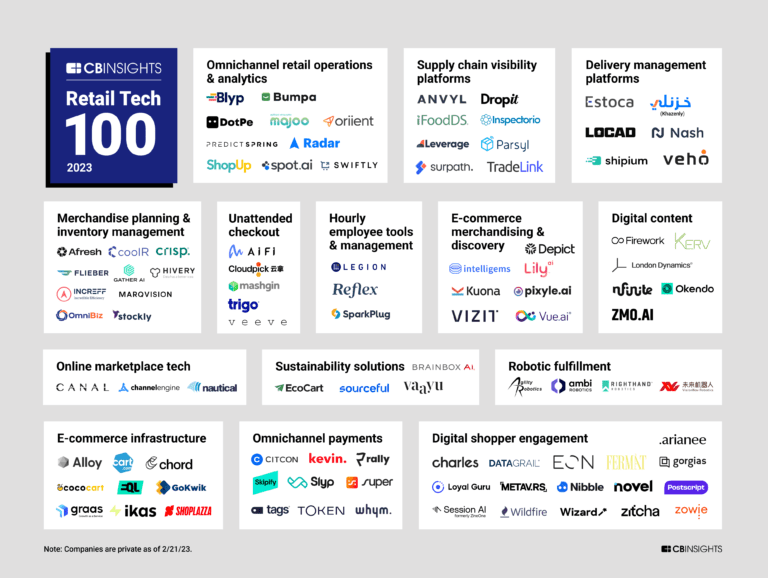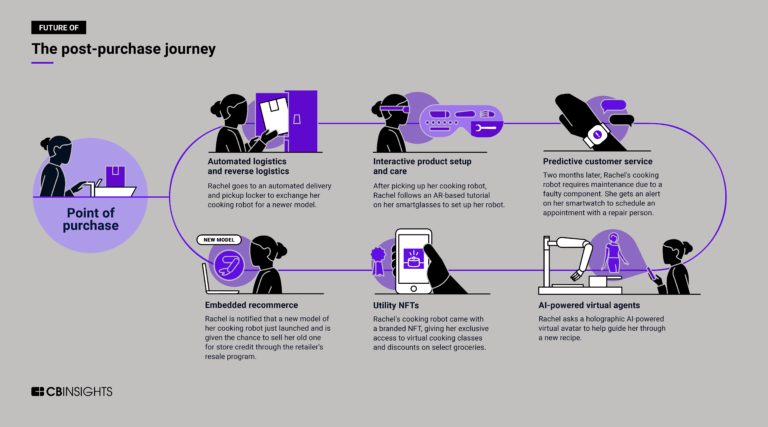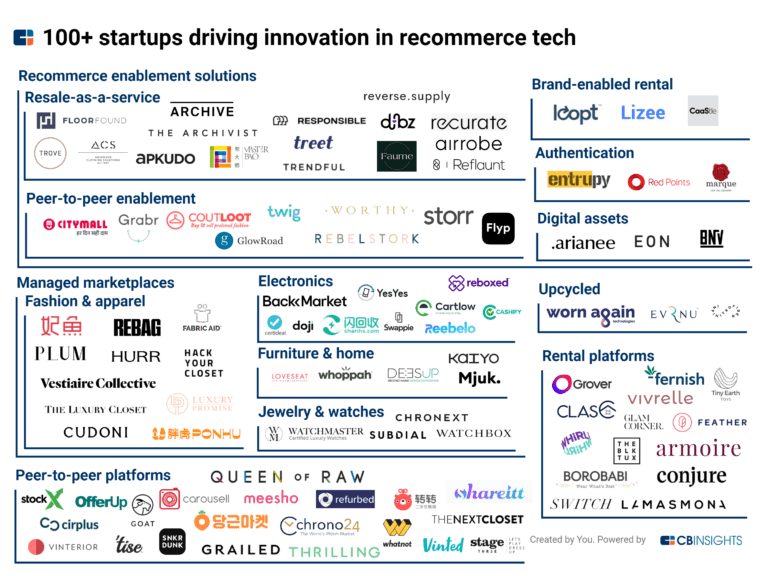EON
Founded Year
2016Stage
Series A | AliveTotal Raised
$12.23MLast Raised
$10M | 1 yr agoAbout EON
EON creates a digital identity (ID) to unlock new business models, customer services, and sustainability. It turns physical products into assets that drive customer relationships, royalties, and insights for brands. The company offers an enterprise product digitization cloud that digitizes, manages, and connects users' products across the full lifecycle with fashion retail’s complete product cloud. It was founded in 2016 and is based in New York, New York.
Missing: EON's Product Demo & Case Studies
Promote your product offering to tech buyers.
Reach 1000s of buyers who use CB Insights to identify vendors, demo products, and make purchasing decisions.
ESPs containing EON
The ESP matrix leverages data and analyst insight to identify and rank leading companies in a given technology landscape.
Sector focused on developing tools to increase traceability and sourcing transparency in the fashion industry via smart labels and platforms. These systems allow consumers to trace items' sourcing journeys, which helps companies bolster their brand transparency and signal their progress on sustainability goals to consumers and investors.
EON named as Leader among 9 other companies, including Kezzler, Sourcemap, and TrusTrace.
Missing: EON's Product & Differentiators
Don’t let your products get skipped. Buyers use our vendor rankings to shortlist companies and drive requests for proposals (RFPs).
Research containing EON
Get data-driven expert analysis from the CB Insights Intelligence Unit.
CB Insights Intelligence Analysts have mentioned EON in 4 CB Insights research briefs, most recently on Mar 14, 2023.

Mar 14, 2023 report
Retail Tech 100: The most promising retail tech startups of 2023

Mar 21, 2022
100+ startups driving innovation in recommerce techExpert Collections containing EON
Expert Collections are analyst-curated lists that highlight the companies you need to know in the most important technology spaces.
EON is included in 3 Expert Collections, including Packaging & Labeling Tech.
Packaging & Labeling Tech
595 items
Companies providing traditional and tech-enabled packaging and labeling solutions for brands.
Retail Tech 100
100 items
The winners of the 2023 CB Insights Retail Tech 100, published March 2023.
E-Commerce
87 items
Latest EON News
Mar 10, 2022
Proponents of the effort to give every item its own digital identity say they’ll unlock numerous benefits for brands and shoppers alike. But for these IDs to work will require overcoming some big obstacles first. Eon's digital ID. (Eon) Key insights A host of startups and other players are working to solve the challenge of giving every item its own digital identity These digital twins could unlock a huge range of benefits for brands and shoppers alike, proponent say But the efforts face big challenges like tagging millions of items, working with data that isn't uniform and getting customers to use the digital twins If an array of start-ups and fashion power players have their way, in the future every item of clothing, watch or handbag you buy will have a digital twin. Scan a QR code on a garment and it would pull up a web page packed with information about that item, from the materials used to styling suggestions and perks, like access to exclusive products. The same web page could even link out to a resale partner, so you can easily list your purchase for sale once you’re done wearing it. If you were the buyer of that used item, you could verify its authenticity by seeing the previous owners going back to its maker. And perhaps, if you were that maker, you could get a royalty every time the item was resold. A product existing at the centre of its own ecosystem of data and services is well-established in other markets, particularly big-ticket, tech-heavy items like cars. But fashion has only dabbled in the idea, such as using RFID tags for inventory tracking in a warehouse. Interest in giving products individual IDs is growing , however, especially as companies and consumers get more comfortable using blockchain technology to unlock new opportunities. Breitling is now issuing blockchain-based digital passports for its watches with features like proof of authenticity and service notifications. Blockchain also powers Hublot’s electronic warranties, which customers activate by taking a picture of their watch with a phone. It’s still a long way from being standard in fashion, though. For certain items made in limited quantities, such as luxury watches, assigning a digital ID is relatively straightforward. But the biggest brands can put millions of items on the market each year, each of which would need a tag such as a QR code or NFC chip. Getting the setup right still leaves the biggest question unanswered: whether customers will use them. Brian Kilcourse, managing partner at the research and advisory firm Retail Systems Research, put it this way: “It has to be more valuable to use it than to ignore it. Consumers aren’t kicking up their heels about this stuff.” Bridging Physical and Digital A host of start-ups are trying to make digital twins commonplace. Many taking on the task, such as Lablaco and Arianee, rely on blockchain for the undertaking, associating each item with its own non-fungible token, or NFT. It’s a method also used by the Aura Blockchain Consortium, a nonprofit formed by luxury power players including LVMH, Prada and Richemont-owned Cartier. Aura has registered “double-digit millions” of products on its private blockchain, Daniela Ott, general secretary of Aura, told BoF last year. Eon, which recently received funding from Imaginary Ventures, the venture firm of Net-a-Porter founder Natalie Massenet and investor Nick Brown, creates IDs that aren’t blockchain-based but says brands can still log them on any blockchain they want. But to make digital IDs as useful as possible requires establishing common standards so each digital ID platform isn’t a closed system with a limited set of capabilities. Brands already have much of the information needed to give their products a basic digital identity in their inventory-management systems, but the data needs to be extracted and processed. Eon’s partners plug into its platform via an API. They so far include luxury and designer businesses, like Yoox Net-a-Porter and Gabriela Hearst, and mass-market retailers such as Target. “All the product data is basically in a vault,” said Natasha Franck, Eon’s founder and chief executive. “We’re saying, ‘okay, there are five million of this sweater in this size, in this colour, produced at this factory.’ And we generate the five million unique, serialized IDs.” The information can be embedded in a QR code, NFC chip or RFID tag and attached during manufacturing. The exact form varies by product. Clothing might get a QR code beside its washing instructions but a handbag might have an NFC chip sewn into it. Eon aims for its platform to be useful at different times in a product’s life. Sustainability information or styling suggestions can be helpful when a customer is shopping. The same menu offering those selections could also provide an option to resell the garment through a participating reseller or guide the user to a textile recycler if the item no longer has resale value. Aura has imagined using digital IDs to enhance the storytelling around luxury goods. Ott said her dream is to show video of the actual person who made a watch or a bag. Lablaco is working to link its digital IDs to virtual versions of the garments. “They can be used for augmented reality experiences such as try-ons,” said Lorenzo Albrighi, Lablaco’s co-founder and chief executive. Lablaco's virtual world. (Lablaco) The company is even building a virtual world where the digital twins can be worn, though its main focus is enabling circularity. H&M trialled its technology for a rental program at a Berlin store last year and it recently worked with Weinsanto on a collection for Dover Street Little Market in Paris. The clothes have “timelines” where their owners can record memories and other content. (Lablaco said it is migrating from the Ethereum blockchain to the less energy-intensive Flow blockchain.) Scaling Up A challenge all players creating digital IDs face is making them as functional as possible. “A product ID is not valuable at all unless it connects to other applications,” Franck explained. It’s why Eon is building a network of partners for its digital twins to link to. Arianee made its protocol open-source for any developer to use. Lablaco is now trying to build an open-ended platform. Its first partner will be FibreTrace, which allows companies to track materials through the supply chain, Albrighi said. More utility may prove key to getting consumers to use these digital identities. “We’re just in very early days,” said Sucharita Kodali, a vice president and principal analyst at Forrester. “They’re building the data layer right now. There needs to be a user layer.” Rival companies may not always cooperate though and may not want to be on the same platform. If digital IDs don’t provide enough value for consumers to pay attention to, it’s uncertain how long brands will devote resources to them. But proponents argue they’ll unlock benefits for brands and shoppers alike. In a recent interview with BoF about Imaginary Ventures’ investment in Eon, whose board she is joining, Massenet described digital IDs as a way to bring physical fashion into web3, an envisioned evolution of the internet toward a decentralised architecture powered largely by blockchain. She likened creating the IDs to laying the railroads at the start of the Industrial Revolution. In her view, commerce has steadily moved away from a centralised model where the consumer, the product and the retailer are together in one location. E-commerce made the product into a data point; the shopper didn’t need to be physically near it and it could be stored in a warehouse. The rise of marketplaces made it so the retailer didn’t even need to own the product, and the spread of peer-to-peer commerce has further decentralised shopping. In this context, products need their own distinct, digitised identities. “We are at the dawn of so many new developments in retail that are going to transform how consumers, brands and businesses interact,” she said. FURTHER READING
EON Frequently Asked Questions (FAQ)
When was EON founded?
EON was founded in 2016.
Where is EON's headquarters?
EON's headquarters is located at 11 West 30th Street, New York.
What is EON's latest funding round?
EON's latest funding round is Series A.
How much did EON raise?
EON raised a total of $12.23M.
Who are the investors of EON?
Investors of EON include Imaginary Ventures, Plug and Play Accelerator and The Circulars.
Who are EON's competitors?
Competitors of EON include Provenance.
Compare EON to Competitors

RoadLaunch is a delivered an IoT platform that makes transportation management fast and automated.

ClearForMe is an API that enables Smart Product Discovery. The API allows online retailers and brands to tailor product recommendations by ingredients customers want or don't want in their SKUs, creating confident product choice.

Digiphy is a marketing, commerce, and traceability platform. Its no-code solution enables brands to go beyond the label and forge stronger customer connections built on trust by combining a quick response (QR) builder with a suite of content templates and third-party traceability and verification data. Digiphy was founded in 2021 and is based in Los Angeles, California.

Retraced uses blockchain technology to collect data and contribute to transparency in the supply chain. The platform offers supply chain management in the fashion and textile industry for the collection, evaluation, and management of supply chain compliance data and connects all parties involved in apparel manufacturing, and provides digitized, standardized, and communication processes. It enables companies to collaborate and gain an overview of their supply chains, trace raw materials back to their origin, anticipate risks, and thus optimize their supply chains in terms of social and environmental aspects. It was founded in 2019 and is based in Dusseldorf, Germany.
Green Story analyzes businesses' pre-existing data to calculate the footprint of products and services and then visualizes the results on the Green Story platform for customers to engage with. This allows businesses to showcase their positive environmental and social impact through intuitive visuals and metrics to positively influence customers' shopping experience.

Compare Ethics operates a product intelligence and compliance platform that enables businesses to manage, verify, and communicate product impact claims at scale. Its AI-powered software verifies product claims at scale and keeps businesses compliant with global regulations. The company serves clients primarily in the United Kingdom. It was founded in 2018 and is based in London, England.
Discover the right solution for your team
The CB Insights tech market intelligence platform analyzes millions of data points on vendors, products, partnerships, and patents to help your team find their next technology solution.
